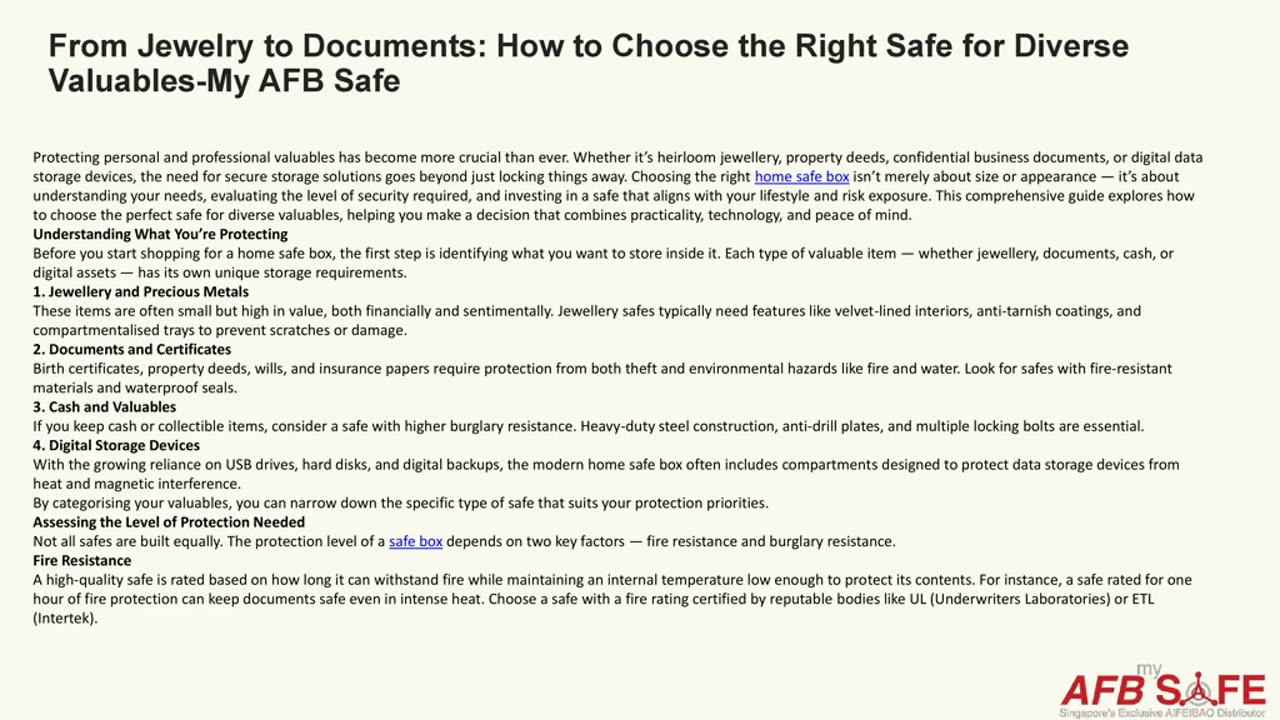Premium Only Content

From Jewelry to Documents: How to Choose the Right Safe for Diverse Valuables-My AFB Safe
Protecting personal and professional valuables has become more crucial than ever. Whether it’s heirloom jewellery, property deeds, confidential business documents, or digital data storage devices, the need for secure storage solutions goes beyond just locking things away. Choosing the right home safe box isn’t merely about size or appearance — it’s about understanding your needs, evaluating the level of security required, and investing in a safe that aligns with your lifestyle and risk exposure. This comprehensive guide explores how to choose the perfect safe for diverse valuables, helping you make a decision that combines practicality, technology, and peace of mind.
Understanding What You’re Protecting
Before you start shopping for a home safe box, the first step is identifying what you want to store inside it. Each type of valuable item — whether jewellery, documents, cash, or digital assets — has its own unique storage requirements.
1. Jewellery and Precious Metals
These items are often small but high in value, both financially and sentimentally. Jewellery safes typically need features like velvet-lined interiors, anti-tarnish coatings, and compartmentalised trays to prevent scratches or damage.
2. Documents and Certificates
Birth certificates, property deeds, wills, and insurance papers require protection from both theft and environmental hazards like fire and water. Look for safes with fire-resistant materials and waterproof seals.
3. Cash and Valuables
If you keep cash or collectible items, consider a safe with higher burglary resistance. Heavy-duty steel construction, anti-drill plates, and multiple locking bolts are essential.
4. Digital Storage Devices
With the growing reliance on USB drives, hard disks, and digital backups, the modern home safe box often includes compartments designed to protect data storage devices from heat and magnetic interference.
By categorising your valuables, you can narrow down the specific type of safe that suits your protection priorities.
Assessing the Level of Protection Needed
Not all safes are built equally. The protection level of a safe box depends on two key factors — fire resistance and burglary resistance.
Fire Resistance
A high-quality safe is rated based on how long it can withstand fire while maintaining an internal temperature low enough to protect its contents. For instance, a safe rated for one hour of fire protection can keep documents safe even in intense heat. Choose a safe with a fire rating certified by reputable bodies like UL (Underwriters Laboratories) or ETL (Intertek).
Burglary Resistance
For theft protection, safes are classified based on construction strength and lock complexity.
A home safe should ideally have solid steel walls, concealed hinges, and advanced locking mechanisms such as digital PINs, biometric fingerprint access, or combination dials.
If you live in a high-risk area or travel frequently, a safe that combines both fireproof and anti-theft features offers a more comprehensive layer of protection.
Choosing the Right Size and Capacity
Selecting the size of your home safe box isn’t as straightforward as it may seem. A common mistake is buying a safe that fits only your current valuables without considering future additions. Always opt for a safe slightly larger than your present needs.
A good rule of thumb is to consider safes in three size categories:
Small (up to 20 litres): Suitable for personal items like passports, cash, and jewellery.
Medium (20–50 litres): Ideal for documents, small electronics, and a few valuables.
Large (above 50 litres): Perfect for households or businesses that require storage for multiple categories of items.
Also, think about where the safe will be installed — whether bolted to the floor, wall-mounted, or hidden within furniture. The placement impacts both convenience and security.
Exploring Locking Mechanisms
A home safe box is only as strong as its locking system. The type of lock determines both accessibility and safety.
1. Key Locks
Traditional and reliable, but keys can be lost or duplicated. They’re best used in combination with other mechanisms.
2. Combination Locks
These mechanical locks use a sequence of numbers. While sturdy and power-free, they require precise handling and can be slower to operate.
3. Digital Locks
Modern safes often feature touch-sensitive digital panels allowing users to set and change passcodes. Some models include time-delay or wrong-entry lockout features.
4. Biometric Locks
The most advanced option, biometric safes grant access through fingerprint or facial recognition. This eliminates key management and enhances user convenience.
For maximum security, consider a home safe box that combines two access methods — like fingerprint and PIN code, or digital keypad and key override — for layered protection.
Installation: Hidden or Visible?
Where you place your safe is a strategic decision. The right location balances accessibility and discretion.
Hidden Safes
Installed behind walls, mirrors, or closets, hidden safes are difficult for intruders to locate. They work best for lightweight valuables or small items.
Floor Safes
These are embedded into the floor, offering high resistance to theft but less convenience for frequent access.
Freestanding Safes
These are larger, often fire-rated, and designed for households that prioritize easy access and visible deterrence.
Always ensure that your home safe box in Singapore is securely anchored to prevent thieves from carrying it away.
Materials and Build Quality
The build quality of a home safe box determines how well it can resist physical attacks and withstand environmental challenges.
Look for safes constructed with solid steel bodies, reinforced doors, and multi-layer lock bolts. Safes with sandwich-structure walls — steel layers filled with concrete or composite material — offer enhanced resistance against cutting tools and fire.
Additionally, safes featuring powder-coated finishes resist rust, while anti-drill and anti-pry designs ensure long-term durability. When combined with smart alarm systems that trigger during tampering, these features provide unmatched protection.
The Role of Smart Technology
Modern safes are evolving rapidly with the integration of digital intelligence. Many advanced home safe box models now feature Wi-Fi connectivity, app-based access, and real-time notifications.
These smart safes allow you to:
Track access logs to know who opened the safe and when.
Receive alerts on your smartphone if an unauthorized attempt is detected.
Remotely lock or disable access when you’re away.
Some even support voice-assisted operation and battery health monitoring, combining convenience with state-of-the-art security.
Budget vs. Value: Finding the Balance
While it may be tempting to opt for the cheapest safe available, remember that your investment should match the value of what you’re protecting.
A home safe box is a long-term security asset. Higher-priced safes often justify their cost through better materials, advanced locking systems, and certified protection levels.
However, balance is key — choose a safe that provides adequate security without exceeding your actual risk level. For instance, if your home has a security alarm system, you might not need the most advanced burglary rating but should focus on fire resistance and digital convenience.
Maintenance and Longevity
Even the best safes require occasional maintenance. Check the batteries in digital or biometric models regularly, lubricate the locking bolts to prevent jamming, and ensure the safe remains moisture-free to avoid internal corrosion.
Modern home safe boxes often include battery health indicators, emergency key overrides, and low-power alerts, simplifying maintenance and ensuring reliable operation over the years.
Choosing the right home safe box isn’t about buying the biggest or most expensive model — it’s about selecting a security solution that meets your unique lifestyle and protection needs. By understanding the type of valuables you own, assessing risk levels, and evaluating material strength, locking technology, and installation options, you can make a confident and informed choice.
A well-chosen safe does more than store possessions — it safeguards your peace of mind, preserves your memories, and protects your legacy. In a world where uncertainty is inevitable, investing in a dependable home safe box is one of the smartest decisions you can make for both your family and your future.
Visits us : https://myafbsafe.com.sg
-
 47:10
47:10
The Rubin Report
3 hours agoWhat Really Happened on ‘The View’ & ‘Curb Your Enthusiasm’ | Cheryl Hines
47.9K16 -
 LIVE
LIVE
LumpyPotatoX2
2 hours agoWhere Winds Meet: New Level Cap + Rumble Wallet - #RumbleGaming
666 watching -
 LIVE
LIVE
The Sufari Hub
2 hours ago🔴WE ARE FEATURED - BLACK OPS 7 EXTRACTION MODE - LEVEL GRINDING
93 watching -
 44:51
44:51
American Thought Leaders
16 hours agoHow This Tech Can Break China’s Rare Earth Monopoly | Dr. James Tour
19K9 -
 9:46
9:46
MattMorseTV
18 hours ago $27.16 earnedTrump just SHUT DOWN a $287,000,000 FRAUD RING.
52.1K108 -
 LIVE
LIVE
JakRazGaming
2 hours agoPlaying Hogwarts Legacy!! Playthrough Stream 4
160 watching -
 1:16
1:16
From Zero → Viral with AI
23 hours ago $1.16 earnedAI Isn’t Killing Work. It’s Killing the Wrong Kind of Work.
12.8K17 -
 2:47:27
2:47:27
Squaring The Circle, A Randall Carlson Podcast
21 hours agoEPIC! Randall & Sabin Howard, Master Sculptor Known As "Michelangelo of America," talk WAR or PEACE!
12.6K2 -
 22:42
22:42
Benjamin Sahlstrom
1 day ago $19.21 earnedHow To Refill 1lb Portable Propane Tanks!
116K15 -
 46:39
46:39
The Bold Lib
1 day agoOwen Shroyer: BOLDTALK W/Angela Belcamino
18.4K25